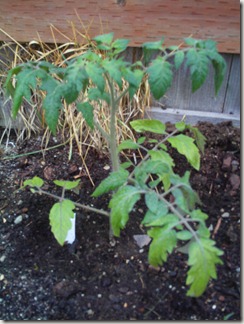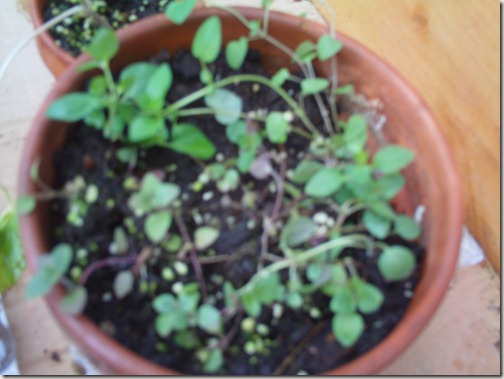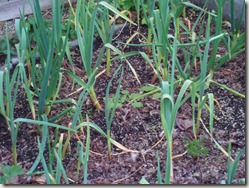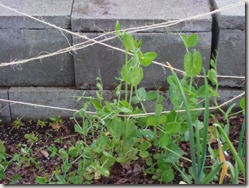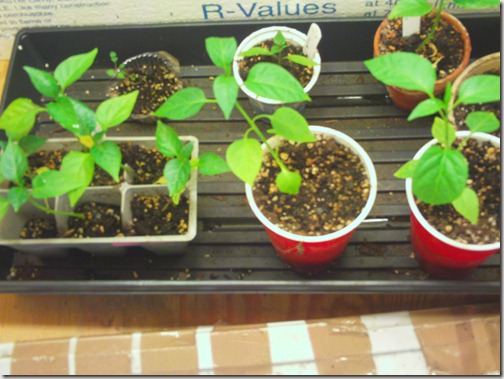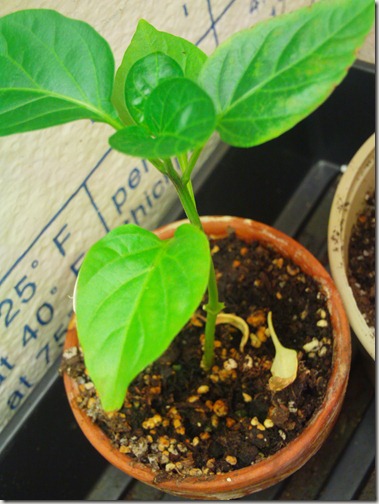Sometimes it is cheaper to not make something yourself
14 years ago dehydrator
Though I will be the first to agree it is much more fun to make something homemade, but in my case this weekend I was better off just making a purchase.
I am growing plenty of herbs this season and want to dry some for convenient use during the cold season. I got the idea to make my own herb dryer. The basic design was to make several one foot squares out of cheap 1” by 2” lumber and attach some window screen stapled to each. Then simply stack as many as needed on a base which consisted of a couple CPU fans and heat source (actual heater coil or light bulb)
In the end my projects was going to cost about $15, which was a great improvement over the $200 price tag on a non Ronco infomercial food dehydrator which requires rotation of trays due to uneven heating.
In an attempt to kill a little time with my two daughters while I know my wife was taking a nap at home I was drawn in by a Garage Sale sign in the distance and found this beauty for the low price of $10.
For those in the food dehydrator circuits this is an original Equi-Flow 7010 and after plugging it in appears to still work great given dark wood construction, I am guessing it just a few years younger than I am.
Time to play with my new toy…
Tags: cheap, herb garden, led, vegetables
Earth Day in the garden
14.1 years ago cilantro, cold season crops, garlic bulbs, onions, peppers, tomato
I decided to take the day off to catch up on some things at home and as I ended up outside of course I went right to the garden.
We have seen a few warm days here in the Northwest and in my area we haven’t dipped under 40 degrees at night so seemed like a good time to plant a few of my tomatoes spending their time this winter in the grow box.
Above are a New Yorker and Persey both of which are new for me this year. They have been growing great even with my neglect during their youth. I also have some Green Zebras, Husky Cherry, Sweetie Cherry, and Yellow Cherry. I did attempt Red Brandywine but the seeds I got appear to be duds.
Given it is always good to have a Plan B so I have twins of these tomato plants still in puts which I can bring if a cold snap comes and kills off the plants I ambitiously planted in the ground.
Elsewhere in the garden I have some herbs: Parsley and Oregano, with Basil being an unfortunately casualty which I will plan on buying from the store and try again next year.
Next I checked out my larger garden bed to see my peas, cilantro, onions, carrots, lettuce, strawberries and garlic
Lastly I checked out the peppers in the grow box which they will stay until we have some warmer nights (at least 50 degrees) otherwise can cause significant stunting of growth. So until then they will remain happy in the grow box and given they are still pretty small, still plenty of room to grow…
Tags: cheap, cilantro, garden seeds, garlic bulbs, growbox, herb garden, outdoor plants, pepper plants, strawberry plants, tomato plants, vegetables
Life in the growbox
14.1 years ago indoor growbox, peppers, tomato
Right about now the temperatures outside should be increasing and I should be thinking about start hardening off my summer plants over the next few weeks.
Unfortunately we seeing hail the past few days along with some pretty cold nights. Looks like even though I was fairly pessimistic about my last frost date I may have another battle of tomatoes/peppers over taking the growbox or bring them out into the elements a little too early…
To make a little room I did move my herbs (oregano/parsley) out to the cold frame with the basil struggling to survive in the growbox I will give it a little time to bounce back.
Tags: cheap, growbox, herb garden, outdoor plants, pepper plants, tomato plants, vegetables
Planning garden using GrowVeg (Year #2)
14.3 years ago garden planning, spring, sprouting
Though GrowVeg worked great for planning my garden last year, this year it became even more useful. By creating a garden plan using my template from my previous year not only did it save time but also showed where I should not plant certain vegetables because I planted the same family of plants in that area last year. Here is my plan for my larger plot:
I am growing much of the same as I have in past years with the addition of broccoli and Swiss chard.
For my longer fence plot here is what I am going with the following:
New in this area I am going to plan on growing some dry beans for storage as well as some green beans along with our regular cucumbers, tomatoes, and sunflowers.
I also have an area I am planning on growing herbs, though for that I am just going to wing it.
In the end it took me about 3-4 minutes to create this plan thanks to GrowVeg which I can print out and keep by the garden so I don’t have to wonder, “Now where did I plant that spinach again.”
They do have a free 30 day trial if you want to try it out this year.
Tags: cheap, herb garden, outdoor plants, tomato plants, vegetables
Cost of Hydroponic Nutrients
14.3 years ago cheap, hydroponics, nutrients
The first time you walk into a hydroponic store there can be a little sticker shock. At first it doesn’t look too bad, $14 for this bottle…oh wait I have to buy these three as well and you leave the store paying $80 to grow some basil and lettuce. Being cheap I like to know how much I will be spending on a hobby before I start out so I did a little exercise.
I took a look at the major nutrient manufacturers and determined using their recommended feeding schedule what it would cost per gallon to complete a 4 week vegetation cycle and a 8 week vegetable and bloom cycle.
To be fair I only included products that provided the primary/secondary macronutrients and micronutrients. Though I am not discounting the effectiveness of various supplements that these companies provide and I wanted to stick with the basics and have a close to an apples to apples comparison as possible.
| Avg, Price | Size | Nutrients Used over 4 weeks (Veg Only) |
Cost per Gallon of mixed nutrients | Nutrients Used over 8 weeks (Veg/Bloom) |
Cost per Gallon of mixed nutrients | |
| General Hydroponics |
$ 1.08 | $ 2.80 | ||||
| FloraGrow | $ 12.50 | qt | 8.08 tsp | $ 0.53 | 12.12 tsp | $ 0.79 |
| FloraBloom | $ 12.50 | qt | 2.02 tsp | $ 0.13 | 14.14 tsp | $ 0.92 |
| FloraMicro | $ 15.95 | qt | 5.05 tsp | $ 0.42 | 13.13 tsp | $ 1.09 |
| Dutch Nutrient Formula |
$ 0.82 | $ 2.30 | ||||
| Advance Grow A |
$ 7.50 | L | 11 tsp | $ 0.41 | 11 tsp | $ 0.41 |
| Advance Grow B |
$ 7.50 | L | 11 tsp | $ 0.41 | 11 tsp | $ 0.41 |
| Advance Flower A |
$ 7.50 | L | 0 tsp | $ – | 20 tsp | $ 0.74 |
| Advance Flower B |
$ 7.50 | L | 0 tsp | $ – | 20 tsp | $ 0.74 |
| Dyna-Gro |
$ 0.66 | $ 2.03 | ||||
| Liquid Grow |
$ 15.00 | qt | 3.5 tsp | $ 0.27 | 3.5 tsp | $ 0.27 |
| Liquid Bloom |
$ 18.95 | qt | 0 tsp | $ – | 7 tsp | $ 0.69 |
| Mag-Pro |
$ 17.95 | qt | 0.875 tsp | $ 0.08 | 3.875 tsp | $ 0.36 |
| Pro-TeKt |
$ 13.90 | qt | 4.25 tsp | $ 0.31 | 9.75 tsp | $ 0.71 |
At first glance these numbers look pretty promising, until you remember the fact that this is the cost per gallon. So if you had a 40 gallon reservoir this can make your cost obvious jump up significantly. Fortunately in my case I only fill my tank up to 9 gallons so a 4 week cycle would cost me on average $7.68 for a 4 week vegetative cycle or $21.39 for a 8 week vegetative and bloom cycle.
Now given I am planning on growing some legal herbs in my hydroponic system (basil/oregano/cilantro) and maybe a little lettuce. This would result in some pretty expensive produce. For this reason and that fact I love chemistry and don’t get to play with it much these days I am planning on going for the less expensive homemade nutrient route, which I will provide more details once I get some more conclusive results of success or failure…
Tags: cheap, cilantro, herb garden, vegetables
pH needs of plants in soil or hydroponics
14.3 years ago hydroponics, pH, water
With the exception of some of my acid loving plants and flowers I normally do not have to worry much about the pH of my soil. This is because I have amended my gardens with nutrient rich soils in raised beds over my alkaline clay I get naturally in my area. This and the fact that due to natural and manmade causes the rainfall is slightly acidic and given the average range for the sweet spot of most edible vegetables (see table below) is 5.8 to 6.0 having your soil slightly acidic this is perfect.
Now when it comes to hydroponics this is entirely different. My tap water has a pH of around 7.5 and the fluctuation of plant using nutrients and transpiration can cause great havoc on the pH on your hydroponic system. Now this creates a challenge but also an opportunity to have control with great precision your pH and keep your plants growing in the sweet spot for the healthiest plants and the greatest yields.
So whether you are growing hydroponically, or simply trying to figure out why your Fennel didn’t do so well last year take a look at the table below, hopefully for some hints of what happened.
Recommended pH Ranges of Vegetables/Herbs
| Plant | Low | High | Plant | Low | High | |
| Artichoke | 6.5 | 7.5 | Millet | 6.0 | 6.5 | |
| Asparagus | 6.0 | 8.0 | Mint | 7.0 | 8.0 | |
| Average | 6.3 | 7.8 | Mushroom | 6.5 | 7.5 | |
| Basil | 5.5 | 6.5 | Mustard | 6.0 | 7.5 | |
| Bean | 6.0 | 7.5 | Okra | 5.5 | 6.0 | |
| Beanroot | 6.0 | 7.5 | Olive | 5.5 | 6.5 | |
| Beet | 6.0 | 6.8 | Onion | 5.5 | 6.5 | |
| Broccoli | 6.0 | 6.8 | Paprika | 7.0 | 8.5 | |
| Brussel Sprouts | 6.0 | 6.8 | Parsley | 5.0 | 7.0 | |
| Cabbage | 6.0 | 6.8 | Parsnip | 6.0 | 6.8 | |
| Calabrese | 6.5 | 7.5 | Pea | 5.8 | 7.0 | |
| Carrot | 6.0 | 6.8 | Peanut | 5.0 | 6.5 | |
| Cauliflower | 6.0 | 6.8 | Pepper | 5.5 | 6.0 | |
| Celery | 6.0 | 6.5 | Peppermint | 6.0 | 7.5 | |
| Chicory | 5.0 | 6.5 | Pistacio | 5.0 | 6.0 | |
| Chinese Cabbage | 6.0 | 7.5 | Potato | 4.5 | 6.5 | |
| Chives | 6.0 | 7.0 | Potato, Sweet | 4.5 | 6.0 | |
| Corn Salad | 6.0 | 6.5 | Pumpkin | 6.0 | 6.8 | |
| Corn, Sweet | 5.8 | 6.8 | Radish | 6.0 | 6.8 | |
| Courgettes | 5.5 | 7.0 | Rice | 5.0 | 6.5 | |
| Cress | 6.0 | 7.0 | Rosemary | 5.0 | 6.0 | |
| Cucumber | 6.0 | 6.8 | Rutabaga | 6.0 | 6.8 | |
| Eggplant | 5.5 | 6.0 | Sage | 5.5 | 6.5 | |
| Fennel | 5.0 | 6.0 | Shallot | 5.5 | 7.0 | |
| Garlic | 5.5 | 7.5 | Sorghum | 5.5 | 7.5 | |
| Ginger | 6.0 | 8.0 | Soybean | 5.5 | 6.5 | |
| Horseradish | 6.0 | 7.0 | Spearmint | 5.5 | 7.5 | |
| Kale | 6.0 | 7.5 | Spinach | 6.0 | 6.5 | |
| Kohlrabi | 6.0 | 6.8 | Squash | 6.0 | 6.8 | |
| Leek | 6.0 | 8.0 | Swede | 5.5 | 7.0 | |
| Lentil | 5.5 | 7.0 | Swiss Chard | 6.0 | 6.5 | |
| Lettuce | 6.0 | 6.5 | Thyme | 5.5 | 7.0 | |
| Marjoram | 6.0 | 7.5 | Tomato | 6.0 | 6.5 | |
| Marrow | 6.0 | 7.5 | Turnip | 6.0 | 6.8 | |
| Melon | 6.0 | 6.8 | Upland Cress | 6.0 | 6.5 |
Tags: garlic bulbs, herb garden, outdoor plants, pepper plants, peppermint plant, tomato plants, vegetables

